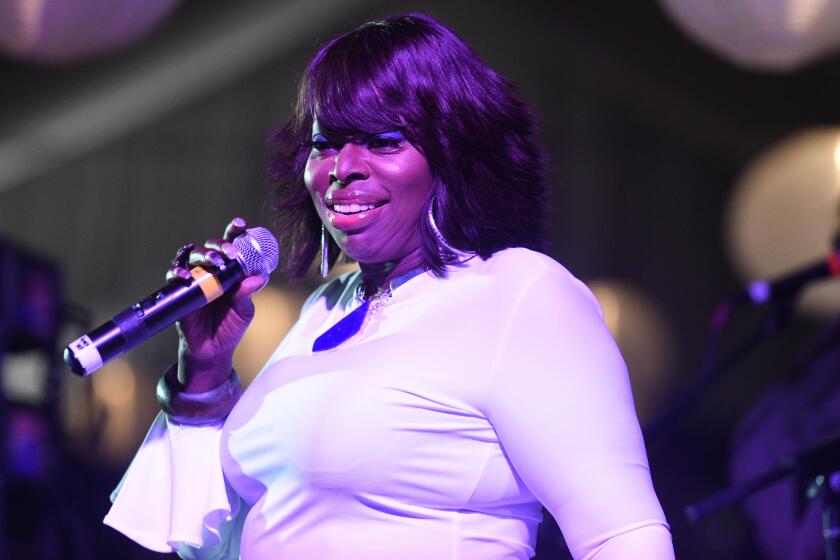How introspective hip-hop artist Roy Kinsey turned trauma into triumph
- Share via
When Roy Kinsey lost his grandmother in 2016, he was too paralyzed with grief to speak at her service. Kinsey couldn’t exalt her the way he wanted — by recounting stories of staying up late with her sharing beers, the hard lessons she passed on or the many memories he had.
So he opted to make her an offering — through music. “If I could make something to show her that I appreciate her and our time,” the 32-year-old thought, “then that’s what I was going to do.”
The result is “Blackie: A Story by Roy Kinsey,” an impressive collection of introspective hip-hop. The work eulogizes his beloved grandmother and offers the rapper’s testimony on personal hardships as well as meditations on life as a black queer man in America.
Released this year, “Blackie” is the fourth record from the Chicago native, who puts out his music independently.
The project was informed by work Kinsey did in search of healing from great loss — revisiting his upbringing, learning about his ancestry, confronting past traumas — and further shaped when the rapper traced the story of his family and did some much-needed self-examination.
“I needed to do some alchemy,” he said. “I wanted to find myself. Who are you? Why are you here? What’s your purpose? I felt like I looked really good on paper, but I wasn’t feeling it. I wasn’t happy, [and] I was trying to get down to the bottom of me, and my family.”
Inspired by “The Warmth of Other Suns,” a book exploring the three waves of the Great Migration where millions of black families left the Jim Crow South and sought refuge up North, Kinsey, who works as a librarian for the Chicago Public Library, wondered how his family members’ migration to Chicago from Mississippi affected their lives and, by extension, his own.
“We don’t know what it was like for our family to pack up and leave because they didn’t feel at home in the South and come up North and not feel at home here either,” he said. “That was the story of my grandmother and my mother … and I wanted to find myself in there somewhere.”
Moved by his reading as well as Kendrick Lamar’s “To Pimp a Butterfly” and Beyoncé’s “Lemonade,” Kinsey sought out to create a message-oriented project, one that tackled the effects of racism, addiction, violence, mental illness and sexuality.
I was feeling very distraught every time I watched the news or listened to the radio. I was feeling a certain way, and I knew I had to say something.
— Roy Kinsey on his concept album, “Blackie: A Story by Roy Kinsey”
Kinsey was born in Chicago to parents who stressed education (they actually met at a library), and music was never at the forefront of his ambitions.
His first exposure to hip-hop came from hearing Bone Thugs-N-Harmony’s “Thuggish Ruggish Bone,” and he fell in love with the genre in middle school with the arrival of DMX and Eve.
Being a hip-hop fan as a gay man isn’t easy by any means, and it’s only tougher as a performer — just look at the dearth of mainstream LGBT acts across mainstream rap, or all of pop, for that matter.
As a genre built on unbridled machismo, homophobic attitudes can be traced through every era and subgenre of rap, and nearly all of the genre’s most influential architects have been guilty of using a gay slur in a lyric at some point.
The aggressive masculinity of hip-hop was appealing to a young Kinsey, who was bullied as a teenager for being “too feminine.”
“I was trying to suppress my sexuality as much as I could throughout high school … to survive,” he said. “I used rap as a measure of masculinity, and men respect rap, so I thought if I dressed and rapped better than all of them, then they wouldn’t be talking about my mannerisms or whatever.”
Even though Kinsey has been out for a decade, his first albums completely evaded his sexuality. He had grown accustomed to masking himself, and he was doing the same in his music, something he reconciled with 2013’s “Beautiful Only” — the album he came out on.
“Although I never lied about who I liked or what I liked, I felt like since I was omitting something very important from the story, I was a fraud,” he said. “I’ve always looked at rap as the most honest art form. I didn’t feel comfortable not addressing it.”
While his last record helped him find his true voice as a rapper, he credits a storytelling class he took while getting his master’s degree in library science for changing his approach to hip-hop.
“Blackie” sounds like the work of a man who spends his days buried in books. It’s deeply autobiographical, but it’s also thick with Kinsey’s observations as a queer black man in America trying to connect the past of the generations before him with today.
Trauma is a constant here — whether experienced through oppression, the loss of a loved one or from what’s happening in the world.
“I was feeling very distraught every time I watched the news or listened to the radio,” he said. “I was feeling a certain way, and I knew I had to say something.”
On “Mississippi Mud,” he wonders what his grandfather could have achieved had he not been forced into sharecropping, and he riffs on police brutality on “Jungle Book.” Elsewhere, he confronts substance abuse and racism and celebrates black femmes. The album’s stark cover, with the artist teary-eyed with his hand over his mouth, is his reaction to black people who have been persecuted and killed.
Ultimately, “Blackie” is about looking inward and backward in hopes that maybe Kinsey could find himself in the present.
“I looked at myself and all of the stress and trauma I’ve been through and thought, ‘Imagine what our ancestors went through,’” he said. “Doing this, I was able to ground myself, find purpose and start to feel healed.”
In celebration of Pride, Roy Kinsey has released a new single, “Black Boy,” which The Times is exclusively premiering. Listen to the new track, which contains adult language, below:
For more music news follow me on Twitter:@GerrickKennedy
More to Read
The biggest entertainment stories
Get our big stories about Hollywood, film, television, music, arts, culture and more right in your inbox as soon as they publish.
You may occasionally receive promotional content from the Los Angeles Times.











